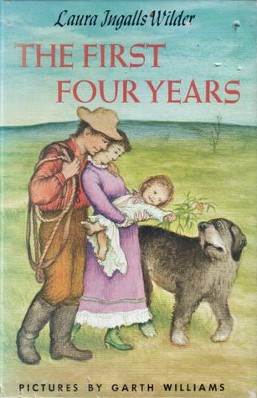The First Four Years (novel) facts for kids

Front dust jacket with Williams' illustration
|
|
| Author | Laura Ingalls Wilder |
|---|---|
| Illustrator | Garth Williams |
| Country | United States |
| Series | Little House |
| Genre | Children's historical novel, realistic fiction Family saga Western |
| Publisher | Harper & Row |
|
Publication date
|
February 1, 1971 |
| Media type | Print (hardcover) |
| Pages | 134 pp. |
| ISBN | 0060264268 |
| OCLC | 855276032 |
| LC Class | PZ7.W6461 Fi |
| Preceded by | These Happy Golden Years |
| Followed by | On the Way Home |
The First Four Years is a special book by Laura Ingalls Wilder. It was published in 1971. Many people see it as the ninth and final book in the famous Little House series. The other eight books in the series told Laura's story up to her marriage to Almanzo Wilder.
This book was found after Laura's daughter, Rose Wilder Lane, passed away in 1968. Roger Lea MacBride, Rose's adopted grandson, found the handwritten story. Laura wrote all her books with a pencil on simple paper tablets. This story was found just as she had written it.
It's not fully clear if Laura meant this story to be another Little House book. She might have written it for adults. The story has some parts that are more grown-up than her other books. Laura probably wrote it around 1940 but then stopped working on it. Roger MacBride decided to publish it just as it was. He only fixed small spelling mistakes. Because Laura never finished editing it, the book feels a bit different from her other Little House stories. But it's still clearly written in her unique style.
Contents
Story Summary: The First Four Years of Marriage
This book gets its name from a promise Laura made to Almanzo. She didn't want to be a farmer. But she agreed to try farming for three years.
Year One: A Tough Start
Laura takes care of their home. Almanzo works the land and looks after their animals. They often go on fun pony rides together. At the end of their first year, their wheat crop was almost ready. It would have earned them about three thousand dollars. This money would have paid off their debts for farm tools and their house. But then, a terrible hailstorm destroyed all their crops.
Year Two: New Home, New Hope
With many debts, Almanzo had to mortgage their homestead land. This meant they had to live on that land. So, they rented out their first house. Almanzo built a small new home on the homestead. In December, their daughter, Rose, was born. By the end of the second year, they harvested a decent wheat crop. They shared the money with the people renting their first house. They earned enough to pay off some smaller debts.
Year Three: Sickness and Changes
In December of the third year, both Laura and Almanzo got very sick. They caught diphtheria. Almanzo had a serious problem after his illness. It left him with a lasting physical weakness. The people renting their first house decided to leave. Almanzo couldn't work both pieces of land anymore. So, they sold the homestead land. They moved back to their first house.
Laura decided to buy a group of sheep. The wool from the sheep helped her earn back her first money. But it was only enough to pay the interest on their debts. Meanwhile, their wheat and oats grew well. But then, several days of hot, dry wind ruined all their crops just before harvest.
Year Four: More Challenges and Hope
At the end of the third year, farming hadn't been easy. But Laura and Almanzo decided to try for one more year. Laura called it a "year of grace." They had no other plans. Almanzo believed they just needed one good year to succeed. Sadly, hot winds ruined their next wheat and oats crops again. Their baby son was born in August. But he died just a few weeks later. Then, their house was destroyed by a sudden fire.
Even after all these hard times, the book ends with hope. Laura feels that their luck will soon change. In real life, they faced many debts. The hot, dry summers in Dakota made them leave their land. They later moved to Mansfield, Missouri. There, they built a successful fruit and dairy farm. They lived comfortably there for the rest of their lives.

